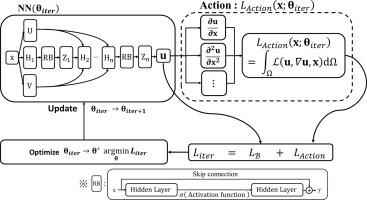A study of PINN incorporating action principle to predict Landau phase transition
IF 3.8
2区 物理与天体物理
Q2 COMPUTER SCIENCE, INTERDISCIPLINARY APPLICATIONS
引用次数: 0
Abstract
The Landau phase transition materials, making significant configurational changes from subtle perturbation given to the system, have garnered considerable interest because they underpin many engineering applications such as display and semiconductor devices. However, understanding and predicting the transition behavior requires accurate simulation of the complex energetics and finding the energetic minimum, which can only be handled by advanced numerical methods. The recent development of Physics-informed Neural Networks (PINNs), capitalizing on the recent development of deep learning methods and ever-increasing computing power, are deemed promising for revolutionizing numerical simulations as they do not require sophisticated numerical methods but the governing equations describing the system. Nevertheless, the capabilities are significantly limited in predicting phase transition and the dissipative characteristics of the system, which is reported for the first time in the present work. In this study, we present a method predicting relaxed states of the system having phase transitions using a PINN that directly minimizes free energy (Action-PINN) based on the action principle instead of a PINN that searches the equilibrium point of free energy (PDE-PINN). Focusing on the Landau modeling, a general free energy model accounting for the first-, and the second-order phase transition, we first demonstrate that the standard PINN is unable to predict the phase transition and leads only to degenerated solutions. We also demonstrate that the proposed variant of PINN can predict more complex phase transition behavior exhibited by liquid crystals in both 2D and 3D. Moreover, we underscore the model’s efficiency and potential for broader applicability through representative numerical examples. Specifically, we demonstrate enhancing solution fidelity through transfer learning, accurate predictions in heterogeneous systems, and end-to-end optimization.This work offers a significant advancement in extending the utility of PINNs for materials having complex behavior, paving the way for future research and applications for Landau phase transition materials.

结合作用原理的PINN预测朗道相变的研究
朗道相变材料可以从系统的微小扰动中产生显著的结构变化,已经引起了相当大的兴趣,因为它们支撑着许多工程应用,如显示和半导体器件。然而,理解和预测相变行为需要精确模拟复杂能量学并找到能量最小值,这只能通过先进的数值方法来处理。基于物理的神经网络(pinn)的最新发展,利用了深度学习方法的最新发展和不断增长的计算能力,被认为有望彻底改变数值模拟,因为它们不需要复杂的数值方法,只需要描述系统的控制方程。然而,在预测相变和系统耗散特性方面的能力明显有限,这在本工作中是第一次报道。在这项研究中,我们提出了一种预测具有相变的系统松弛状态的方法,使用基于作用原理的直接最小化自由能的PINN (action -PINN)来代替搜索自由能平衡点的PINN (PDE-PINN)。关注朗道模型(一种用于一阶和二阶相变的一般自由能模型),我们首先证明了标准PINN无法预测相变,只会导致退化解。我们还证明了所提出的PINN变体可以预测液晶在2D和3D中表现出的更复杂的相变行为。此外,我们通过具有代表性的数值实例强调了该模型的有效性和更广泛适用性的潜力。具体来说,我们展示了通过迁移学习、异构系统的准确预测和端到端优化来提高解决方案的保真度。这项工作在扩展pin在具有复杂行为的材料中的应用方面取得了重大进展,为未来朗道相变材料的研究和应用铺平了道路。
本文章由计算机程序翻译,如有差异,请以英文原文为准。
求助全文
约1分钟内获得全文
求助全文
来源期刊

Journal of Computational Physics
物理-计算机:跨学科应用
CiteScore
7.60
自引率
14.60%
发文量
763
审稿时长
5.8 months
期刊介绍:
Journal of Computational Physics thoroughly treats the computational aspects of physical problems, presenting techniques for the numerical solution of mathematical equations arising in all areas of physics. The journal seeks to emphasize methods that cross disciplinary boundaries.
The Journal of Computational Physics also publishes short notes of 4 pages or less (including figures, tables, and references but excluding title pages). Letters to the Editor commenting on articles already published in this Journal will also be considered. Neither notes nor letters should have an abstract.
 求助内容:
求助内容: 应助结果提醒方式:
应助结果提醒方式:


